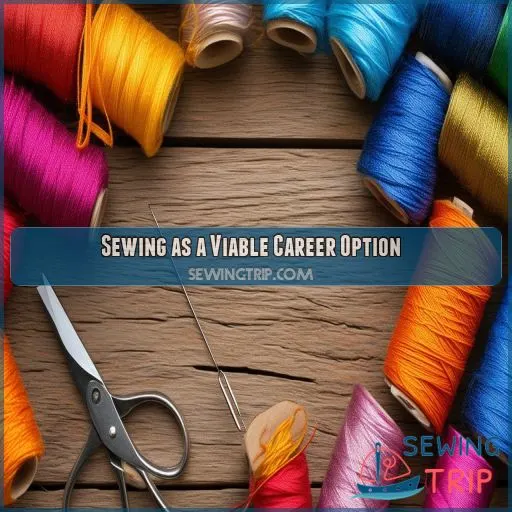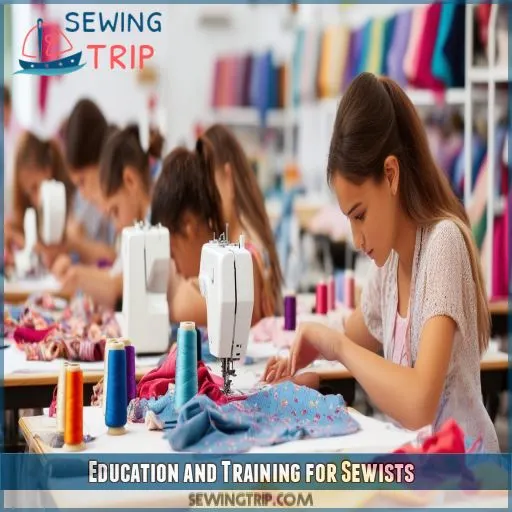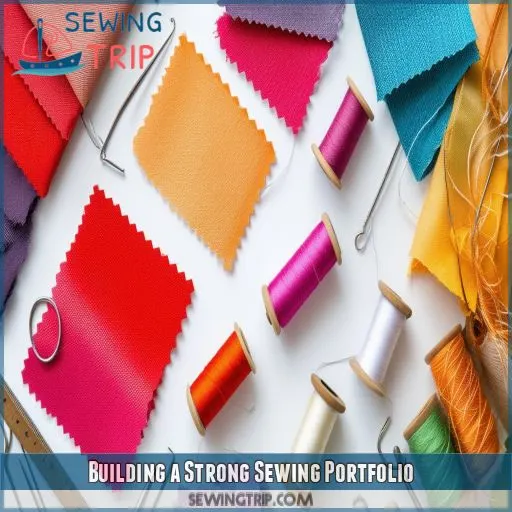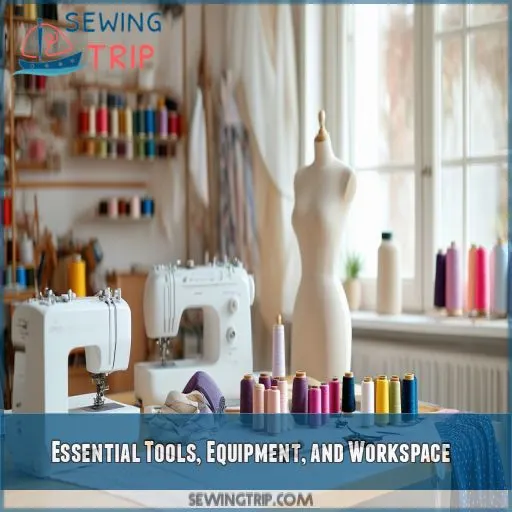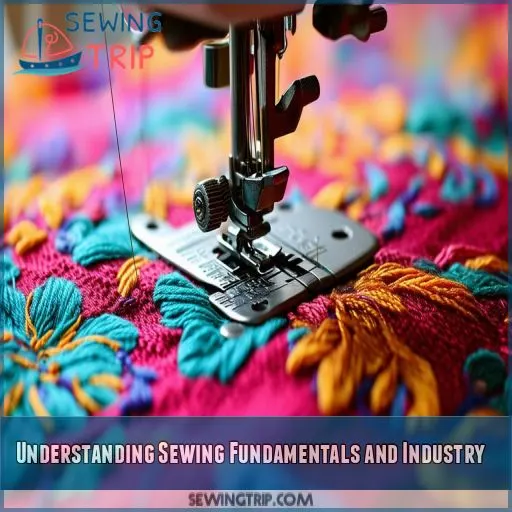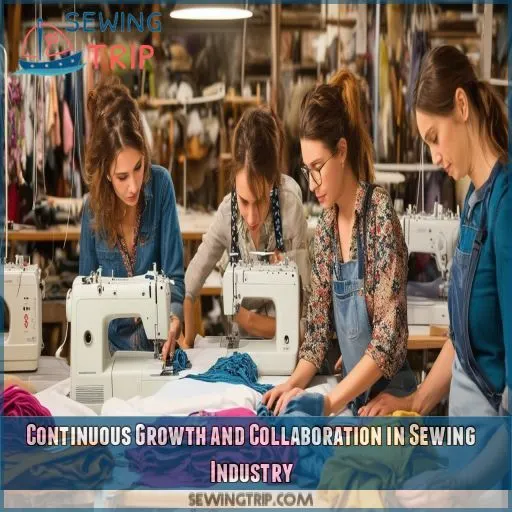This site is supported by our readers. We may earn a commission, at no cost to you, if you purchase through links.

This profession provides a wide range of options, from establishing your own alterations business to crafting custom fashion creations.
By honing essential skills and unleashing your creativity, you can turn your passion into a successful venture in the dynamic textile and fashion industry.
Explore the diverse career trajectories, vital training, and equipment necessary to thrive and excel within this continually evolving field.
Table Of Contents
- Key Takeaways
- Sewing as a Viable Career Option
- Exploring Career Paths in Textile and Fashion Industry
- Education and Training for Sewists
- Building a Strong Sewing Portfolio
- Essential Tools, Equipment, and Workspace
- Understanding Sewing Fundamentals and Industry
- Overcoming Fear and Building Confidence
- Continuous Growth and Collaboration in Sewing Industry
- Frequently Asked Questions (FAQs)
- Conclusion
Key Takeaways
- The sewing industry offers a diverse range of career opportunities, from entrepreneurship to fashion technology, catering to different strengths, abilities, and artistic inclinations.
- Building a strong sewing portfolio is crucial for showcasing skills and attracting clients or employers, utilizing both digital platforms and physical portfolios to increase visibility.
- Investing in the right tools and equipment, such as sewing machines and quilting tools, is essential for advancing sewing focus and ensuring an efficient and comfortable workspace layout.
- Continuous growth and collaboration in the sewing industry is vital for thriving, requiring knowledge-seeking, professional development, networking within the sewing community, and embracing challenges.
Sewing as a Viable Career Option
Sewing as a career offers a wide range of exciting possibilities beyond a mere hobby or side hustle. It’s a vibrant industry with numerous opportunities, from factory jobs to entrepreneurship, showcasing the high demand for sewing skills. As a seamstress, tailor, or designer, your sewing talent can open doors to various career paths.
The sewing industry is undergoing a renaissance, fueled by consumers’ growing appetite for unique, handcrafted items. This shift in consumer preferences presents a unique opportunity for sewists to transform their passion into a successful career. Sewing specialists are in high demand, and with the right set of skills, you can find your unique place in this dynamic field.
The variety of sewing jobs is impressive, ranging from textile management to sales and design roles. Each position plays a crucial role in bringing sewn goods to life and delivering fashion and functionality to a global audience. Whether your interests lie in quality control, fashion design, or starting your own business, sewing can provide a gratifying and empowering career journey.
The sewing community is a vibrant and diverse network, offering a wealth of knowledge and collaborative opportunities. By embracing challenges, networking, and continuously honing your skills, you can reach the pinnacle of your craft and empower yourself to turn your sewing dreams into a thriving reality.
Exploring Career Paths in Textile and Fashion Industry
The sewing industry presents a diverse range of career avenues, each offering distinct opportunities for creative collaboration, innovation, and consumer interaction. No matter if you feel a pull towards the complex world of textile manufacturing or see yourself as a fashion designer, there’s a spot for you in this vibrant field.
Think about the varied roles within the sewing community, from the exactness of a machine operator controlling industrial sewing machinery to the creative expression of an alterations expert refining garments to perfection. The resurgence of the sewing industry, fueled by consumers’ increasing desire for one-of-a-kind, handmade goods, has presented sewists with the chance to transform their passion into a sustainable career or side gig.
Investigate the possibilities of entrepreneurship, where creating a custom sewing or tailoring enterprise is an option, or step into the stimulating world of fashion technology, merging traditional expertise with groundbreaking advancements. The path you select will be influenced by your distinctive combination of strengths, abilities, and artistic inclinations.
The fashion sales and marketing domain also invites you in, offering positions such as retail sales associate, stylist, or personal shopper, where you assist consumers along their fashion expeditions. Alternatively, your niche could be in design and distribution, forming visual concepts, and then actualizing them through production and retail.
The multitude of career trajectories in the textile and fashion industry guarantee that your abilities will discover their ideal application, empowering you to pursue your passions and make your mark on the fashion and sewing landscape.
Education and Training for Sewists
To become a sewist, you’ll need to master the fundamentals, and that translates to getting a grasp on sewing theory. You can opt for sewing classes, either locally or online, to build a strong foundation. Here are some routes you can take:
- Local community colleges and vocational schools: Offering a variety of courses, these places provide a structured learning environment.
- Sewing studios: They offer hands-on practice alongside experienced sewists.
- Online communities and tutorials: Engage with a diverse group of sewists and learn from a wide range of teachers.
- Industry insights and sewing software: Stay relevant and understand the business aspects of sewing.
- Practice: Welcome challenges, and view mistakes as learning opportunities.
Building a Strong Sewing Portfolio
Building a robust sewing portfolio is key to showcasing your skills and attracting clients or employers. Creating a well-curated portfolio is a powerful tool for displaying your talent and unique niche within the sewing world.
So, how do you create an impressive portfolio? Start by documenting your projects with detailed descriptions and visual content. Include photographs and videos that showcase intricate details, highlighting your expertise and versatility. This visual documentation is essential for potential clients or employers to understand the range of your capabilities.
When crafting your portfolio, display a variety of projects that exhibit your ability to take on different challenges. Whether you specialize in garment construction or home decor, present a diverse range of techniques and showcase your talent across various sewing domains.
Don’t underestimate the power of digital platforms. Creating an online presence through websites, blogs, or social media can greatly increase your visibility and bring opportunities. However, don’t neglect the impact of a physical portfolio. It allows for an intimate and tangible presentation of your craftsmanship.
Essential Tools, Equipment, and Workspace
Now that you’ve built a solid portfolio, let’s discuss tools and workspace. Investing in the right equipment is essential for advancing your sewing focus, be it garment sewing or quilting. Here are some key considerations:
- Sewing Machines: Select a machine that aligns with your skills and goals. Regardless of your experience level, go for a dependable, long-lasting machine with features that support your specific projects.
- Quilting Tools: If quilting is your forte, splurge on high-quality quilting tools. Rotary cutters, self-healing mats, and specialized rulers will elevate your quilting game by adding precision and streamlining your process.
- Workspace Layout: Design a functional workspace that includes adequate storage and a designated cutting area. A thoughtful layout significantly improves your comfort, efficiency, and overall sewing satisfaction.
- Budgeting for Tools: While acquiring quality tools is a wise investment, stay attuned to your budget. Renting specialized equipment for one-off projects can be a cost-effective approach that doesn’t sacrifice craftsmanship.
Understanding Sewing Fundamentals and Industry
As you enter the sewing industry, it’s imperative to grasp the basics of sewing and understand the industry’s broader landscape.
Begin by refining your sewing abilities, as they form the core of your creative pursuit. Aspire to grasp a comprehensive view of the business, including production and retail, alongside design. While structured learning is advantageous, complement it with diverse sources of knowledge to widen your horizons and refine your skills. Embrace the act of practicing, as mistakes are common and offer learning opportunities.
Examine ready-to-wear clothing to enhance your comprehension of construction and fabric selection. Explore fabric shops to familiarize yourself with various materials and their distinct attributes. Through this immersion, you’ll develop an innate sense of the sewing industry and unlock its creative potential.
Overcoming Fear and Building Confidence
As you enter sewing, it’s normal to feel intimidated or uncertain. Here are tips to help overcome fears and boost confidence:
- Embrace Mistakes: Welcome mistakes as learning opportunities. Don’t let perfectionism hold you back. Accept that they’re part of the process, and use them to improve.
Continuous Growth and Collaboration in Sewing Industry
The sewing industry is brimming with opportunities for continuous growth and collaboration. To thrive in this industry, you should seek knowledge and professional development. Read extensively, especially visually inspiring books, to expose yourself to a myriad of styles and ideas. Challenge yourself to improve and set ambitious goals, never becoming complacent. Utilize online resources and books to stay abreast of industry developments and trends. Consider enrolling in a reputable school to gain a strong foundation and network with influential industry professionals. This will open doors to valuable connections and potential collaborations.
Networking within the sewing community is paramount. By building relationships with like-minded individuals, you can gain insights, receive mentorship, and collaborate creatively. Explore diverse paths, such as fashion design, home decoration, or craft enthusiasm, to find your unique niche. Remember, growth and collaboration go hand in hand, and by embracing challenges, you’ll discover a world of opportunities for personal and professional advancement.
Frequently Asked Questions (FAQs)
Can you make a living from sewing?
Yes, you can make a living from sewing. Sewing is a dedicated lifestyle, and you can turn your passion into a career or side hustle. You can sell handmade goods, teach sewing, or even sell patterns you’ve created.
How to make a career from sewing?
Sewing is a thread that can stitch together a colorful career tapestry. To make a career out of sewing, you must first master the craft. Education is key: learn from experts, embrace challenges, and network within the sewing community.
Build a portfolio showcasing your unique skills and niche. Whether you’re a garment guru or quilting queen, invest in the right tools and create a workspace fit for a seamster. With practice, persistence, and a passion for fashion, you’ll sew success.
What is the profession of sewing called?
Sewing skills can be applied to a variety of professions, including fashion design, textile research, textile production, textile marketing and sales, and fashion publicity.
Is it hard to get into sewing?
Sewing’s difficulty depends on your project. Sewing clothes is harder than quilts, but a pieced quilt is harder than a simple skirt. Sewing has start-up costs for necessities like needles, thread, scissors, and fabric.
How do I find my niche in the sewing industry?
To find your niche, reflect on your sewing journey, strengths, and interests. Embrace challenges, seek diverse knowledge, and stay open to new ideas. This exploration will guide you to your sweet spot, where your passion and expertise align.
How important is it to invest in sewing equipment?
Investing in quality sewing equipment is essential to producing good work. Start with essentials like fabric scissors and pins, then expand your collection as your skills and interests grow.
What are some good ways to network in the sewing community?
Join online communities, share your projects, goals, and resources, and invite others to join you. Ask questions, and watch sewing videos and podcasts to get inspired and connect with others.
How can I build a strong sewing portfolio?
A portfolio should showcase your skills and tell your story. Include 25-30 looks, your design sketches, and fabric swatches. Start with your strongest look, and save your second-strongest for last.
Where can I find sewing classes to improve my skills?
Sewing classes are widely available, both online and in-person. Online platforms like Udemy, YouTube, and Bark offer free or low-cost courses for beginners. For more advanced instruction, the New York Sewing Center provides expert-oriented classes. Local community colleges, vocational schools, and sewing studios are also great options.
Conclusion
The sewing career field is a diverse landscape, presenting an array of avenues to pursue. This article serves as an extensive guide to transforming your sewing hobby into a thriving business.
By recognizing the varied career paths, obtaining the required education and skills, and creating a solid portfolio, you can thrive in the fashion and textile industry.
Remember to invest in essential tools, equipment, and a designated workspace to actualize your designs.
Always remember that a career in sewing is a journey filled with evolution and growth, so embrace development and cooperation within this vibrant field.

